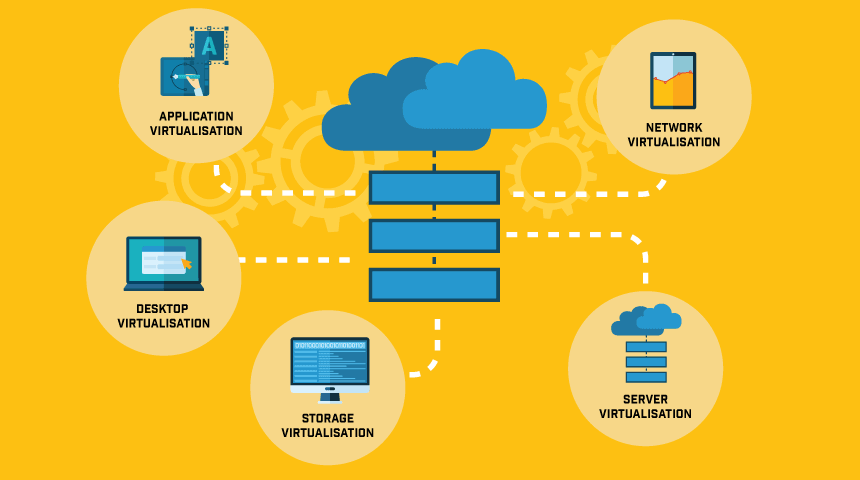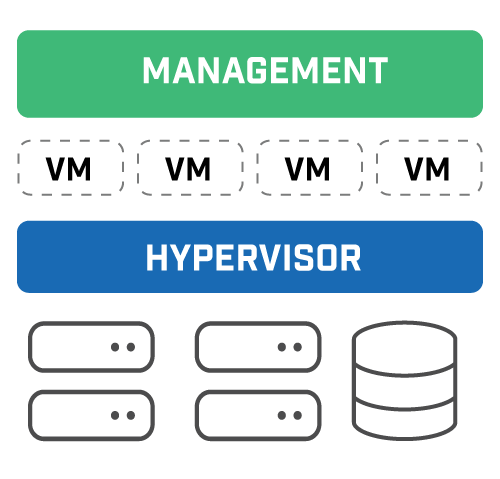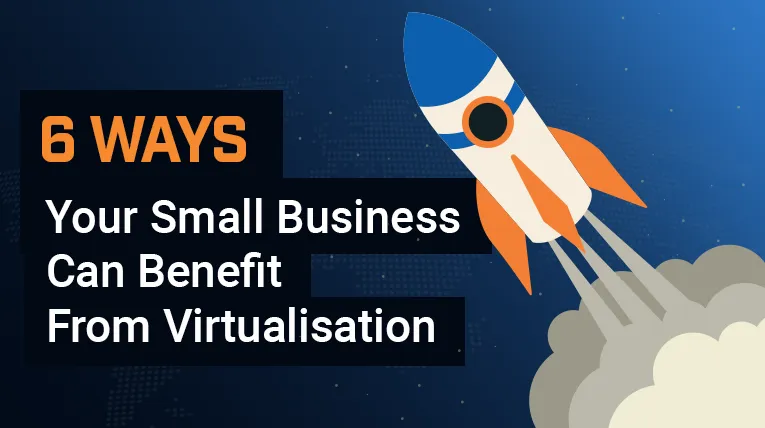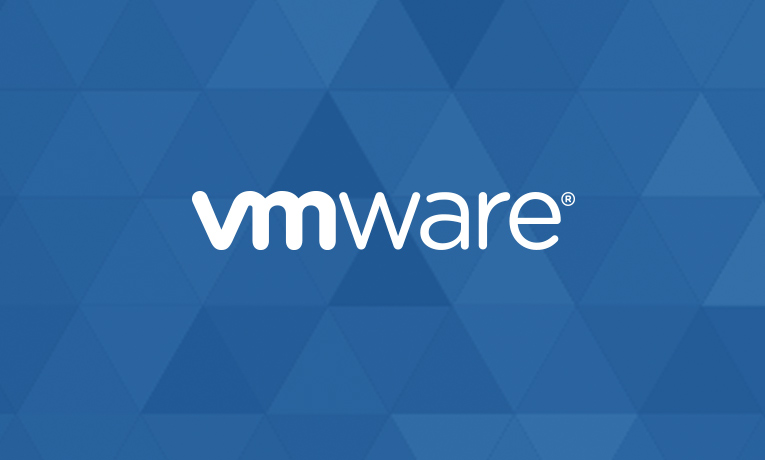Guide to Virtualisation
Last Updated: July 22nd, 2025 11 min read Servers Australia

What is virtualisation?
Virtualisation is the process of creating a virtual version of something – such as an operating system, a server, a storage device, or a network resource. It allows multiple operating systems or applications to run simultaneously on a single physical machine, allowing resources to be shared and utilised more efficiently.
Virtualisation is widely used in data centres, virtual data centres and cloud hosting environments to improve resource utilisation, reduce hardware costs, and increase flexibility and scalability. It can also improve security by isolating applications and workloads from each other and simplify management by allowing administrators to manage multiple virtual machines from a single interface.
Types of virtualisation
There are several types of virtualisation. The most common types include:
Server virtualisation
Desktop virtualisation
Network virtualisation
Storage virtualisation
Application virtulisation
Each type of virtualisation has its own specific benefits and use cases, but they all share the goal of increasing efficiency and flexibility while reducing costs and complexity.

Server Virtualisation
Server virtualisation involves using physical servers to run multiple virtual machines. Each server is installed with specialised software – called a hypervisor or virtual machine monitor – that allows multiple virtual machines to operate simultaneously on the same physical hardware.
Virtualisation servers can run a variety of operating systems (eg. Windows, Linux, or Unix) and can host multiple virtual machines running different operating systems. Each virtual machine is isolated from the others and has its own virtual CPU, memory, disk, and network interface.
Virtualisation servers are used in data centres and cloud hosting environments to maximise resource utilisation, reduce hardware costs, and increase flexibility and scalability. Common use case include:
Creating virtualised environments for testing and development
Running multiple operating systems on a single physical machine
Hosting cloud-based services and applications
There are several popular virtual server products on the market, including VMware ESXi, Microsoft Hyper-V, and Citrix XenServer. These products offer a range of features and capabilities like live migration, high availability, and disaster recovery.
Desktop virtualisation
Desktop virtualisation, also known as virtual desktop infrastructure (VDI), is a technology that allows multiple virtual desktops to run on a single physical machine. With desktop virtualisation, the operating system, applications, and user data are separated from the physical hardware and run in a virtual machine that is hosted on a remote server.
Desktop virtualisation offers several benefits, including improved security, centralised management, and flexible access to desktops from anywhere with an internet connection. It also allows organisations to reduce hardware costs, simplify software deployment, and provide a consistent desktop environment for users.
Types of desktop virtualisation
Hosted virtual desktops: Virtual desktops are hosted on remote servers and accessed by users through a thin client or web browser.
Local virtual desktops: Virtual desktops run on the user's local machine using virtualisation software like VMware Workstation or Oracle VirtualBox.
Remote desktop services: Desktops are hosted on a server and accessed by users through a remote desktop protocol (RDP) client.
Application virtualisation: Only the applications are virtualised, and users access them through a web browser or remote desktop client.
Desktop virtualisation can be deployed in various ways, including on-premises infrastructure, cloud-based infrastructure, or a hybrid model that combines both. Popular desktop virtualisation products include VMware Horizon, Citrix Virtual Apps and Desktops, and Microsoft Remote Desktop Services.
Network virtualisation
Network virtualisation is a technology that allows multiple virtual networks to run on a single physical network infrastructure. In network virtualisation, the physical network resources – like switches, routers, and servers – are abstracted and divided into multiple virtual networks, each with its own resources and policies.
Network virtualisation offers several benefits, including improved resource utilisation, simplified network management, and increased flexibility and agility. It also allows organisations to create isolated virtual networks for different applications and workloads, which can improve security and compliance.
Types of network virtualisation
Virtual LANs (VLANs): VLANs allow multiple virtual networks to run on the same physical network infrastructure, using different VLAN IDs to segregate traffic.
Virtual Private Networks (VPNs): VPNs create secure connections between remote networks or users, allowing them to access resources on a private network over the internet.
Software-defined networking (SDN): SDN is a network virtualisation technology that separates the network control plane from the data plane, allowing network administrators to manage network traffic and policies centrally.
Network function virtualisation (NFV): NFV virtualises network functions (firewalls, routers, and load balancers) as software allowing them to run on standard servers.
Network virtualisation can be deployed in multiple ways, including on-premises infrastructure, cloud-based infrastructure, or a hybrid model that combines both. Popular network virtualisation products include VMware NSX, VMware applications, Cisco ACI, and Microsoft Azure Virtual Network.
Storage virtualisation
Storage virtualisation allows multiple physical storage devices to be abstracted and presented as a single logical storage pool. With this technology the physical storage resources – eg. hard drives and solid-state drives – are combined and managed as a single resource, which can be allocated to different applications and workloads as needed.
Storage virtualisation offers several benefits, including improved storage utilisation, simplified storage management, and increased flexibility and scalability. It also allows organisations to create virtual storage devices that are independent of the underlying physical storage hardware, which can reduce costs and simplify migration and backup processes.
Types of storage virtualisation
Storage area network (SAN) virtualisation: SAN virtualisation allows multiple physical storage devices to be combined into a single virtual storage pool, which can be accessed by multiple servers.
Network-attached storage (NAS) virtualisation: NAS virtualisation allows multiple physical NAS devices to be combined and presented as a single virtual NAS device, which can be accessed by multiple clients.
Object storage virtualisation: Object storage virtualisation allows multiple physical object storage devices to be combined and managed as a single virtual storage pool, which can be accessed by multiple applications and workloads.
Storage virtualisation can be deployed in on-premises infrastructure, cloud-based infrastructure, or a hybrid model that combines both. Popular storage virtualisation products include VMware vSAN, Microsoft Storage Spaces, and IBM Spectrum Virtualise.
Application Virtualisation
Application virtualisation is a technology that allows applications to run in an isolated environment, separate from the underlying operating system and other applications. This isolation helps in avoiding conflicts between applications and allows for more efficient management of software resources. Here are some key aspects of application virtualisation.
Isolation:
Application virtualisation isolates applications from each other and from the underlying operating system. Each virtualised application runs in its own "sandbox," ensuring that it does not interfere with other applications or the system itself.
Compatibility:
Virtualisation can help resolve compatibility issues between applications and the operating system. This is particularly useful when running older applications on newer operating systems, as virtualisation can create an environment that mimics the required conditions for the application to run.
Portability:
Virtualised applications like VMware can be encapsulated and packaged, making them more portable. This allows users to run applications on different machines without the need for complex installations or modifications to the host system.
Simplified Management:
Application virtualisation simplifies the management of software deployment and updates. Since each application is encapsulated, administrators can manage and update applications independently, without affecting other software on the system.
Resource Efficiency:
Virtualised applications consume fewer system resources compared to traditional installations. This can lead to improved performance and efficiency, especially in environments with multiple applications running simultaneously.
Security:
Application virtualisation can enhance security by isolating applications from the underlying system. This isolation can help prevent malware or vulnerabilities in one application from affecting others or the overall system.
Benefits of virtualisation
Virtualisation offers several key benefits for IT environments, including:
Improved resource utilisation: Through server virtualisation, multiple virtual machines can run on a single physical server, optimising hardware usage and reducing the need for multiple physical machines. This consolidation results in cost savings, energy efficiency, and a more scalable infrastructure.
Flexibility and agility: Virtualisation allows for the rapid deployment of virtual machines and applications, enabling quick adaptation to changing business needs. This agility is crucial for organisations that require scalable and dynamic IT environments.
Enhanced disaster recovery and business continuity: Virtualisation enables the creation of snapshots and backups of virtual machines, making it easier to recover from system failures or disasters. These snapshots can be quickly deployed on other virtualised servers, minimising downtime and ensuring business continuity.
Virtualisation allows for the rapid deployment of virtual machines and applications, enabling quick adaptation to changing business needs.
Improved testing and development processes: Virtual environments provide a controlled and reproducible setting for software testing, reducing the risk of conflicts and streamlining the development lifecycle. This is particularly beneficial for software developers and quality assurance teams.
Centralised management: By hosting desktop environments on centralised servers, IT administrators can more efficiently manage and maintain user desktops, ensuring consistent configurations and security policies.
Enhanced security: Isolation between virtual machines and the ability to create and test snapshots contribute to a more secure computing environment. In the event of a security breach, virtualisation allows for the quick restoration of a clean and unaffected state.
Overall, virtualisation improves efficiency, flexibility, scalability, and security in IT infrastructures, making it a fundamental technology for modern computing environments.
About the hypervisor

At the heart of virtualisation is the hypervisor, also known as a Virtual Machine Monitor (VMM). Situated between the hardware and the operating systems, the hypervisor facilitates the creation and management of multiple virtual machines (VMs) on a single physical server. It allocates and controls resources such as CPU, memory, and storage, ensuring each VM operates independently and securely.
Two types of hypervisors
Type 1, or bare-metal, runs directly on the hardware and is dedicated to virtualisation.
Type 2, or hosted, runs atop an existing operating system. The hypervisor plays a critical role in optimising resource utilisation, enabling efficient sharing of hardware resources among VMs, and ensuring the isolation and stability of virtualised environments.
Choosing the right server for virtualisation
Processor (CPU)
Choose a server with a multi-core processor to handle the demands of running multiple virtual machines (VMs) simultaneously. Look for processors that support hardware virtualisation features like Intel VT-x or AMD-V.
Memory (RAM)
Adequate RAM is crucial for virtualisation. Ensure the server has enough RAM to support the total memory requirements of all planned VMs. Consider future scalability needs when determining the amount of RAM.
Storage
Use fast and reliable storage, such as SSDs, to ensure quick access to data for VMs. Consider the storage capacity based on the anticipated storage needs of the virtualised workloads.
Networking
Ensure the server has multiple high-speed network interfaces to handle the increased network traffic associated with virtualisation.
Consider support for advanced networking features like VLANs and Quality of Service (QoS).
Hypervisor Compatibility
Choose a server that is compatible with the hypervisor (virtualisation software) you plan to use, whether it's VMware, Microsoft Hyper-V, or another platform.
Management Features
Opt for servers that offer remote management capabilities, such as out-of-band management interfaces (e.g., IPMI, iDRAC, iLO), to facilitate remote administration and troubleshooting.
Scalability
Consider the future growth of your virtualised environment. Choose a server that allows for easy expansion of resources, such as adding more RAM, storage, or additional processors.
Redundancy and Reliability
Select a server with redundant components (power supplies, fans) to enhance reliability and minimise downtime. Consider server features like ECC (Error-Correcting Code) memory for improved data integrity.
Budget
Evaluate your budget constraints and aim for the best balance of performance, features, and scalability within your financial limits.
Certifications and Support
Check for certifications and compatibility with your virtualisation platform. Some vendors offer certified configurations that are tested and optimised for specific virtualisation software.
Consider the level of support provided by the server manufacturer, especially if deploying virtualisation in a critical business environment.
Energy Efficiency
Choose servers that are energy-efficient to reduce operational costs. Look for ENERGY STAR certification and other energy-efficient features.
Virtualisation Security
Ensuring the security of virtualised environments is paramount in safeguarding sensitive data and maintaining the integrity of IT infrastructures. Virtualisation introduces unique security challenges that require comprehensive measures. One key concern is the hypervisor's security, as it represents the core layer overseeing multiple virtual machines (VMs). Regular updates and patch management for the hypervisor are crucial to address potential vulnerabilities.
Regular updates and patch management for the hypervisor are crucial to address potential vulnerabilities
Isolation between VMs must be rigorously maintained to prevent unauthorised access or data leakage. Implementing network security measures within the virtual environment, such as firewalls and intrusion detection systems, adds an extra layer of protection. Secure configuration practices, like minimising the use of unnecessary services and employing strong authentication mechanisms, help fortify the overall virtualisation security posture.
Regular audits and monitoring of virtualised systems enable prompt detection of anomalies or suspicious activities. Virtual machine snapshots, while useful for backups, should be managed securely to avoid unintended exposure of sensitive information. As virtualisation extends to cloud environments, encryption of data in transit and at rest becomes imperative.
A layered approach to security – involving collaboration between virtualisation platform providers, IT administrators, and security experts – is essential to stay ahead of evolving threats and ensure a resilient security framework for virtualised infrastructures.
Ready for your journey to virtualisation?
Get powerful, scalable, high performance virtualisation for your business.


